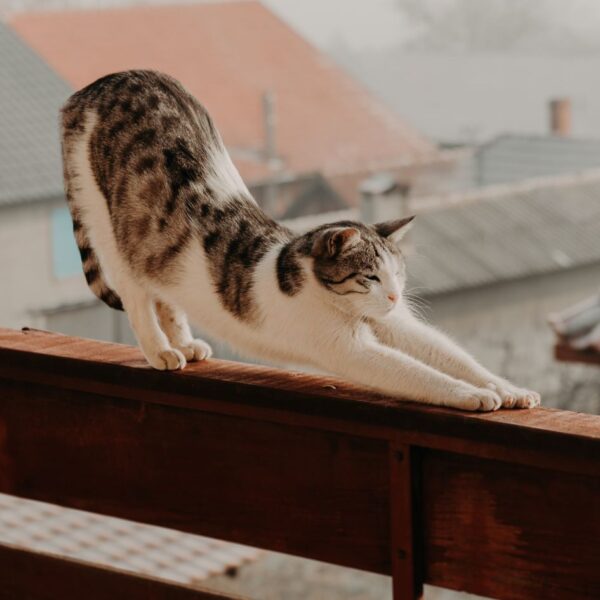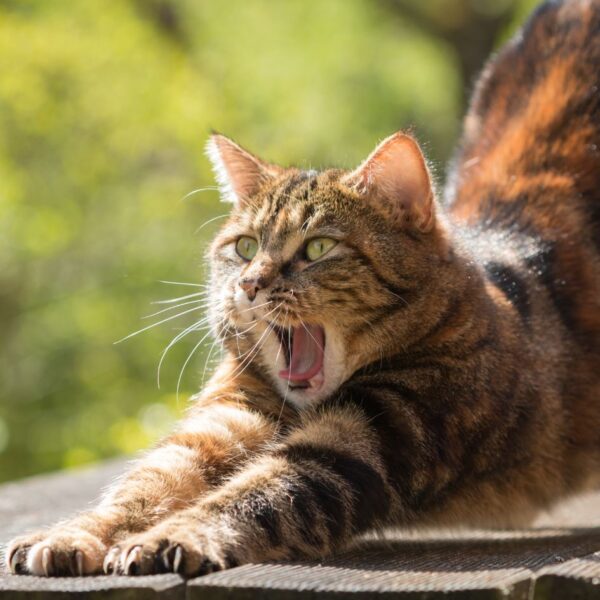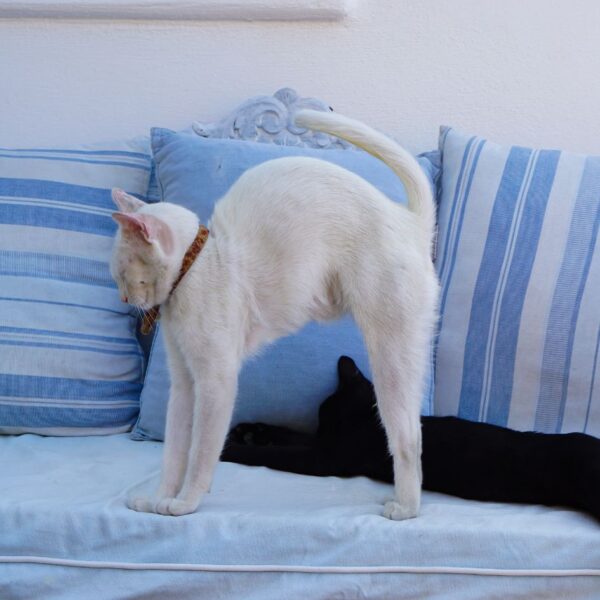
Why Do Cats Stretch: Feline Flexibility and Behavior
Cats are renowned for their grace and agility, which is often showcased through their extensive range of motion and stretching behavior. We sometimes call kitty stretches cat yoga. This innate activity is not just a whimsical action but is deeply rooted in their physiology and survival mechanisms. Stretching serves multiple purposes for a cat, from preparing their muscles for activity to reinforcing their natural instincts. Often observed after long periods of rest, cats instinctively stretch to awaken their senses and align their bodies for the day’s activities.
The act of stretching aligns closely with a feline’s physical health and well-being. It is a way to maintain muscle tone, flexibility, and reduce the potential for injury. Moreover, stretching can be a cat’s method of expressing contentment and communicating their mood. For a domesticated cat, stretching is as much a part of their daily routine as it is a reflexive response that ensures they remain limber and ready for whatever the day may bring.
Key Takeaways
- Stretching is essential for a cat’s muscle tone, flexibility, and injury prevention.
- It is a natural behavior that supports both their physical health and behavioral expression.
- Understanding the reasons behind a cat’s stretching can enhance care and well-being.
Fundamentals of Feline Stretching
Stretching is a fundamental aspect of a feline’s behavior that serves various physiological purposes. It is crucial for maintaining muscle flexibility and joint health.
Science Behind Cat Stretching
Cats instinctively stretch to activate their muscles and joints after periods of rest. This behavior contributes to maintaining their agility and prepares them for activity. Stretching stimulates blood flow to the muscle fibers, which enhances nutrient delivery and waste removal. The physiological range through which felines stretch their muscles can be variable and is typically governed by their natural locomotor activities such as walking, trotting, and galloping.
Role of Muscles and Tendons in Stretching
The importance of muscles and tendons in feline stretching cannot be overstated:
- Muscles: They contract and extend to produce movement and generate heat to warm up the body’s tissues.
- Tendons: These are elastic tissues that connect muscles to bones, allowing the transfer of force and enabling cats to stretch and flex their joints.
Musculoskeletal health is critical for a cat’s mobility. Regular stretching can help maintain the elasticity of muscles and tendons, promoting long-term mobility and minimizing the risk of injury.

Physical Benefits of Stretching or cat yoga
Cat yoga serves a multitude of physical benefits for kitties, ranging from enhanced flexibility to improved circulation. These benefits contribute to a cat’s overall physical well-being and are a testament to the importance of this natural behavior.
cat yoga Enhances Flexibility and Limberness
Cats instinctively stretch to maintain flexibility and a state of limberness. This regular activity helps to lengthen their muscles, which can prevent stiffness and maintain the fluid grace with which they move. The act of stretching activates muscle fibers, promoting a state of readiness for the sudden bursts of activity cats are known for.
Supporting Joint Health and Range of Motion
Regular stretching contributes significantly to joint health by maintaining and enhancing the range of motion. This beneficial activity prevents joint stiffness and supports the health of the connective tissues surrounding the joints. For felines, who often engage in high-impact activities such as jumping and running, maintaining good joint health is crucial.
Improving Blood Circulation
Stretching also plays a role in boosting blood circulation. When felines stretch, it results in increased blood flow to their muscles and joints, providing essential nutrients and oxygen to these areas. Enhanced circulation not only helps to keep the muscles well-nourished but also contributes to a swifter removal of metabolic waste products.

Behavioral Aspects of Stretching or cat yoga
Cats exhibit a range of stretching behaviors that serve diverse functions from preadjustment and communication to marking their territory.
Stretching as a Preadjustment Behavior
When cats stretch, it often signifies a transition from a state of rest to more vigorous activity. This behavior prepares their muscles for the demands of being an agile predator. By stretching, a cat elongates its muscles, which can increase blood flow and prepare it for sudden movements necessary to catch prey, like a feather or a mouse. It is not uncommon to see a cat extend its paws, flex its claws, and elongate its body in what appears to be a deliberate preadjustment routine before pouncing on a toy or engaging in play.
Communication Through Stretching
Felines use stretching as a form of body language to communicate various messages. A kitty who stretches in the presence of a human or another animal might be indicating that it feels comfortable and secure in its environment. Alternatively, a cat might stretch to show a relaxed state or even to demonstrate affection, as when a cat reaches out its paws toward a human or kneads on a soft surface. Such behaviors can signal a cat’s contentment and social bonding intentions.
Stretching and Territory Marking
Stretching plays a critical role in how cats mark territory. During a stretch, especially when coupled with clawing at a scratching post, a cat activates scent glands located in its paws. By doing so, it leaves a scent mark that signifies possession and warns other animals. This marking behavior serves as a clear statement of ownership and establishes spatial boundaries that other cats are instinctively compelled to respect.

Health and Well-Being
Cat yoga behaviors contribute significantly to their physical and emotional health. Proper stretching aids in muscle tension release, stress relief, and overall well-being, ensuring that cats maintain a balance between a relaxed state and readiness for activity.
Stretching to Alleviate Stress and Anxiety
Cats instinctively stretch to relieve stress and anxiety. The act of stretching releases endorphins in the brain, which are natural “feel-good” chemicals, contributing to a state of relaxation and contentment. Regular stretching also triggers the release of pheromones, which can help reduce a cat’s anxiety levels and lower blood pressure, fostering a sense of calmness.
Aging and the Importance of Stretching
As cats age, their flexibility and mobility can decline. Routine stretching is crucial for maintaining muscle tone and joint health, which can prolong an aging cat’s active lifestyle. Veterinarians often recommend regular stretching to help older cats keep their circulation flowing well, ensuring that muscles remain strong and that toxins are efficiently flushed from the body.
cat yoga or Stretching to Assist Digestion and Relaxation
Stretching plays a role in the digestive health of cats. After meals, stretching can assist the stomach in processing food and aid in the movement of ingested material through the digestive tract. Moreover, a relaxed and stretched body can improve overall circulation, increasing the comfort level of cats, particularly after they have consumed a large meal.
Each subsection here is tailored to portray the factual relationship between stretching and various health and well-being aspects of felines, emphasizing the importance of stretching across different stages and states of their life.

cat Stretching in Context
Stretching is an essential behavior in felines, serving both physiological and psychological purposes. It’s particularly observable after periods of sleep or inactivity as well as surrounding their physical activities.
After Sleep or Inactivity
Cats often engage in stretching immediately after waking up from sleep, which is typically followed by a yawn. This instinctive behavior helps to wake up their muscles and prevent stiffness. During a catnap, a cat’s muscles remain relatively inactive; stretching upon waking helps to re-limber these muscles, preparing the cat for activity.
- Prevents stiffness: Keeps muscles and joints supple.
- Stimulates blood flow: Helps with circulation after a period of rest.
Before and After Physical Activity
Just as athletes stretch before and after exercise, cats instinctively perform stretching behaviors before and after engaging in physical activity. Stretching prepares their muscles for the sudden bursts of energy required for jumping and running, and it’s also crucial for cooling down to help their bodies ease back into a state of rest.
- Prepares the body: Enhances flexibility and performance.
- Releases endorphins: Contributes to a cat’s feeling of well-being.
By incorporating stretching into their routine, kitties maintain their agility and reduce the risk of injury. This behavior is deeply ingrained and has both immediate and long-term benefits for their health and vitality.
parent’s Guide to Cat Stretching
Understanding why and how felines stretch can play a significant role in ensuring their well-being. It helps cat parents recognize normal behavior, promote healthy routines, and discern when veterinary advice is necessary.
Interpreting Your Cat’s Stretching
Cats instinctively perform a variety of stretches such as the full-body stretch, side stretch, and neck stretch. A full-body stretch often signifies contentment and is a way for cats to prepare their muscles for activity. Side stretches may indicate an intention to become more alert or active. Observing a cat’s stretching can help a guardian understand their cat’s current state and intentions.
Promoting Healthy Stretching Habits
Stretching benefits cats by maintaining flexibility, improving posture, reducing the risk of muscle cramps, and facilitating the release of lactic acid. To encourage healthy stretching habits:
- Use Toys: Utilize toys that encourage full-body extension, like wand toys to motivate the cat to reach and stretch.
- Create a Conducive Environment: Ensure ample space for the cat to stretch out, incorporating elevated platforms and scratching posts that encourage various types of stretches.
When to Consult a Veterinarian
While stretching is beneficial for felines, certain behaviors may indicate health issues:
- Persistent Stretching: Excessive and repetitive stretching could be a signal of arthritis or muscle cramps.
- Changes in Behavior: A decrease in stretching activity or obvious discomfort during stretching might warrant a consultation with a veterinarian.
Monitoring stretching habits and consulting with a professional when changes occur can aid in early detection and treatment of potential health concerns.

Frequently Asked Questions
Felines are known for their stretching behaviors across various contexts, from social greetings to post-nap routines. This section addresses common inquiries regarding why cats stretch in these different situations.
What causes cats to stretch when they greet someone?
When kitties stretch upon greeting someone, it is often a sign of trust and comfort. They expose their vulnerable areas as a friendly gesture, indicating that they feel safe and relaxed around the person.
What is the reason cats stretch when being petted?
Stretching when being petted can be a reflexive response to the stimulation of touch, as it increases circulation and enhances muscle flexibility. Additionally, it may be an expression of enjoyment and a way for felines to encourage more petting.
How does cat yoga benefit a cat’s legs, especially their back legs?
Cat yoga benefits a cat’s legs, especially the back legs, by promoting muscle tone and flexibility. It helps maintain the reflexes and agility that are essential for a cat’s hunting and jumping activities.
What is the significance of cats stretching during their sleep?
Cats often stretch during their sleep to awaken their muscles and promote blood flow after a period of inactivity. This behavior helps to prepare their body for activity and prevent muscle stiffness.
How does stretching relate to a cat’s behavior after eating?
After eating, cats may stretch to aid digestion and start the process of toning their muscles, which can become sluggish following a meal. It is also a transition from a resting state to a more active one as they prepare to engage in their routine activities.
Why do cats extend their paws onto people?
Felines may extend their paws onto people as a form of communication and to seek attention. It can be an affectionate gesture or a request for interaction, such as petting or play, from their human companions.